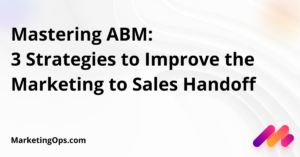It’s your first day in a new job. Congrats! Feeling overwhelmed yet? When a company decides to open a new marketing operations position, it’s usually because something is already broken and needs fixing.
Before you jump straight into problem-solving mode, consider how you can use your first 90 days to prove your value as a strategist rather than an order taker. Yes, there will be tasks and projects that you’ll be expected to take on during this initial period, but if you can find a balance between tactical work, development, and strategy, you’ll become an invaluable asset to your company and be more in control of the work that you get to do.
You can use this 30-60-90 day plan as a guide to getting started or as a way to rejuvenate your existing marketing operations role if you feel like you’re not being effectively utilized, or even during the interview process for a new role.
First 30 days
When you first start any new job, including a MOps position, onboarding into a new company can be overwhelming. That’s why your first 30 days should primarily be about collecting information and familiarizing yourself with your team, tech stack, and processes.
First and foremost, you need to get to know your go-to-market team. That includes leaders, end-users, and operations personnel in marketing, sales, and client success, plus any agencies or vendors you work with to support GTM. Set up a few 1:1 meetings each week to interview members of these groups and collect information you will need in order to effectively conduct a marketing operations audit later on.
Use this rubric to ensure you are checking off those segments, along with some possible job titles for each:
|
Marketing |
Sales |
Client Success |
Agencies / Vendors |
| Leaders |
CMO, VP or Director of Marketing |
CRO, Head of Sales/Business Development |
CCO, COO, VP of Client Success |
Account Managers for SaaS solutions, Account Executives at Agencies, Consultants, ect. |
| End-users |
Marketing Manager, Marketing Specialist |
Account Executive, SDR or BDR |
Client Success Manager, Customer Experience Manager |
| Operations |
Marketing Operations Manager |
Sales Operations Manager, Revenue Operations Manager |
Client Success Operations Manager |
Key Information to Collect
KPIs & other important metrics – Understanding how each department is evaluated can help you to recognize what data is most important to sync between systems and report upon in dashboards. Leadership may want to measure their departments on data that isn’t currently being reported upon. You can rack up credibility early on by making that valuable data more accessible.
Ideal Customer Profile – If you are supporting a full marketing department, you probably won’t be creating content for your audience. But that doesn’t mean you shouldn’t understand the ideal customer profile (ICP). Understanding company firmographics such as size, industry, geography, company revenue, technology used, as well as any signals of market readiness.
If your company uses account-based marketing techniques, you can help your team prioritize which accounts to target based on this data. You can also automate Account Stages to measure accounts’ level of engagement with your company.
Marketing Qualified Lead and Sales Qualified Lead Criteria – Similar to ICP data, you’ll want to understand how your market and sales teams qualify at the contact/lead level.
Ask what contact demographics, such as job title, job seniority, location, etc., make up a good lead as well as what measurable interactions they must have with your company before they are ready to be handed from marketing to sales. This could include hitting a certain lead scoring threshold, hand-raises (for example, filling out a Demo Request form), or other factors.
Contact Acquisition Channels – Once you understand what makes a good lead, you’ll want to find out where those leads come from. Some common acquisition channels include conference and events, sales outreach, and your website (which may be further broken into advertising, social media, organic search, marketing emails, podcasts, etc.). How are each of these channels measured? Which ones produce the most leads? Which ones require the most budget?
Lead Flow Process – Once a contact is added to your customer relationship management (CRM) platform, what happens next? How does a contact progress down the marketing and sales funnel?
Usually there are Lead Stages that measure a contact’s current level of engagement with your company all the way from contact creation to active client (and beyond!). What triggers the change from stage to stage? How much of that is automated? Where are the manual touch-points and processes? What are the conversion rates between the stages? How long does it typically take contacts to move from one stage to another?
Your work could help improve the conversion rates between stages and the velocity at which leads move through the funnel.
Deal Flow Process – Once a contact reaches a stage where they are actively conversing with sales about a potential purchase, often a deal is created to track that particular sale. Deals (or Opportunities depending on your CRM) have their own subset of stages and their own criteria that needs to be met to move from one stage to another. While this process is likely managed by sales operations, it is still helpful for you to understand how it fits into the lead flow.
Attribution Process – Once a deal closes, your company gets revenue. That’s awesome! But wait…where did that deal come from?
If marketing doesn’t have a process in place to track attribution, it’s likely that sales will get all the credit (and when it comes time for budget cuts, marketing activities that can’t be associated with influencing revenue are often first on the chopping block).
If your company does have a revenue attribution strategy, what type of model are they using. A single touch model will attribute all revenue to the first or last touch an associated contact has before a deal is created. A multi-touch model will distribute attribution across a number of activities that contacts have had prior to deal creation.
Client Success Systems & Processes – Client success is often thought of as separate from the marketing and sales “revenue” team. However, this is changing as more companies begin to lump them together into a cohesive Go-To-Market team.
Understanding what happens after someone becomes a client and how their experience is captured and reported back to marketing and sales is vital to increasing your company’s recurring revenue, as well as helping you identify candidates for success stories, case studies, testimonials, and referrals. How are client health, churn, and retention reported? How do clients submit support requests and feedback? Who is responsible for reaching out to clients for success stories?
Hand-offs Between Teams – The most common place where operational processes fall apart is in the hand-off between teams. What is the process for passing a lead from marketing to sales? What about from sales to client success? How much of those processes are automated? Is there an onboarding process for new clients to ease the transition? How are you marketing to active sales opportunities and existing clients? What about when a client churns? Who is responsible for the churned client?
Team Capabilities / Responsibilities – What responsibilities aren’t being covered by anyone or are being shared inefficiently across team members? Does your team have the capability set to do the job at hand? Are there overlaps in responsibility where duplication of work is happening? Or gaps where work is falling through the cracks?
Challenges & Pain Points – What are your co-workers least favorite parts of their jobs? What manual processes are they doing regularly that could be automated?
While these initial calls with your team will likely be highly informational, don’t forget to get to know your co-workers as people as well. As you continue to build new relationships across the marketing, sales, and client success teams, be sure to sit down with those team members and get a “day in the life” view of their role. You may be surprised at what you can discover and find more ways to help!
First 60 Days
Once you have met your team and understand their processes and pain points, it’s time to do a deep dive into the tech. The information you collected during the interviews is essential context to understanding what role technology plays in their day-to-day and how it enables (or hinders) go-to-market strategy.
To conduct a full system audit, you’ll want to create a document that covers:
- The names of all tools in the tech stack
- The intended and practical use cases for those tools
- Which other tools each system is integrated with
(Alternatively, you could use MarketingOps.com’s Marketing Ops Playbook Template!)
Think you’re done? Dig deeper. If you document assets within your platforms such as automations, campaigns, reports, lists, properties, you’ll be able to make recommendations around data hygiene and platform organization.
You’ll also want to consider how technology plays a role in compliance. Does your team have standardized processes around GDPR and CANSPAM? Are those processes working?
During this audit, see if there are opportunities for quick wins – solutions that you can implement quickly and efficiently to give yourself credibility early on.
Once you have the full lay-of-the-land re: your tech stack, you should be able to determine what overlaps and gaps exist in the tech stack. Think about what important information is stored in each. What information is not being synced across systems? Is there a single-source of truth for reporting? If so, what data is missing from that system.
Using this information you can make recommendations about how to optimize the tech stack to create efficiencies or even save your company money by purging unnecessary systems.
The other essential aspect of an audit is creating a map of the client journey and the various touch points they have through these stages:
- Contact acquisition
- Pre-opportunity lead flow
- Opportunity to close deal flow
- Client onboarding
- Client ongoing support
- Client success stories
As you go, note any bottlenecks and friction points that may affect the client experience. What are the conversion rates from stage to stage? At what points are contacts being evaluated to move back up the funnel? Also, identify where the manual processes are for your team members and try to diagnose any challenges surfaced in your interviews.
First 90 Days
After you’ve met your team, learned their processes, conducted a systems audit, and mapped the client journey, you’re ready to bring the strategy!
Review all of the information you have collected and create recommendations for how your company can improve its marketing operations. Put these insights into a slide deck and schedule time to present your recommendations to go-to-market leaders.
Beyond 90 Days
Auditing your tech stack and the processes between your go-to-market teams should be a pretty regular activity over the course of your tenure as the marketing or revenue ops pro. Don’t be afraid to set a schedule a year or more in advance to come back and review what you’ve built.







